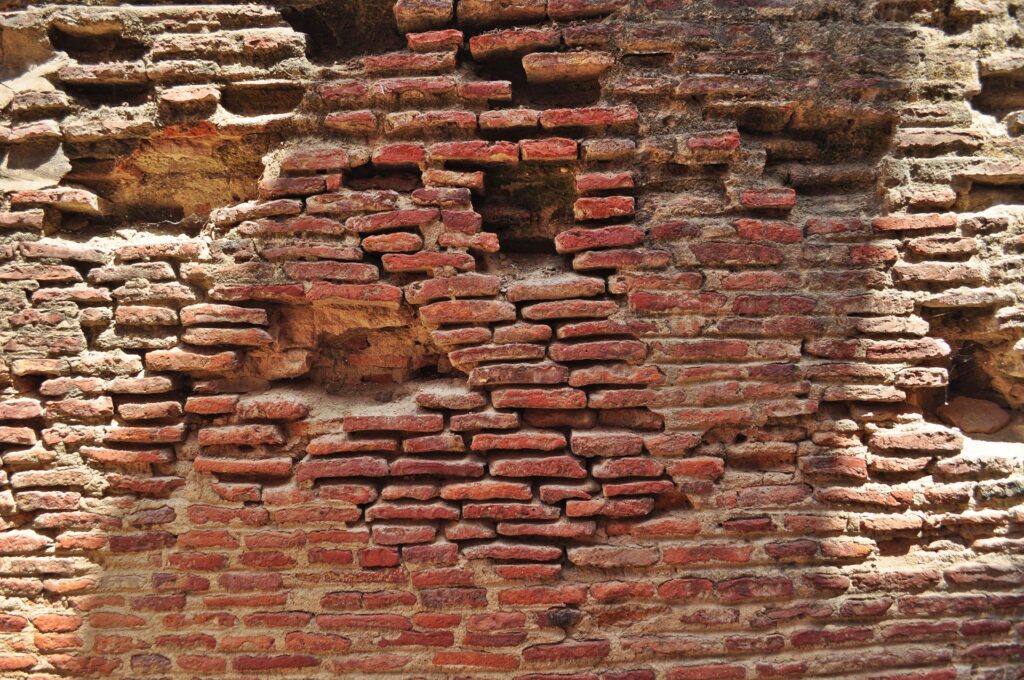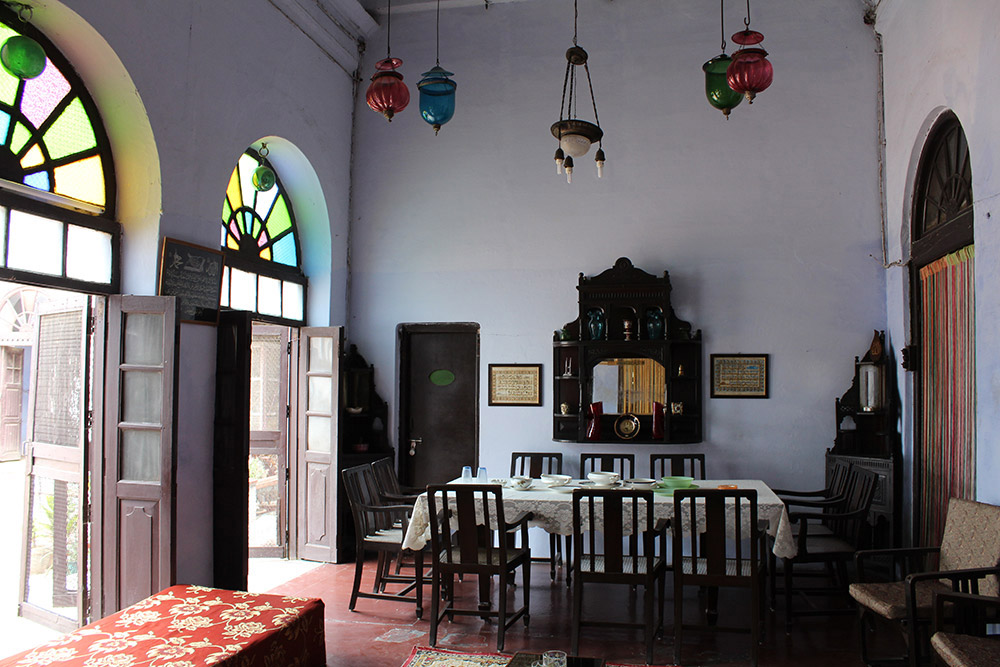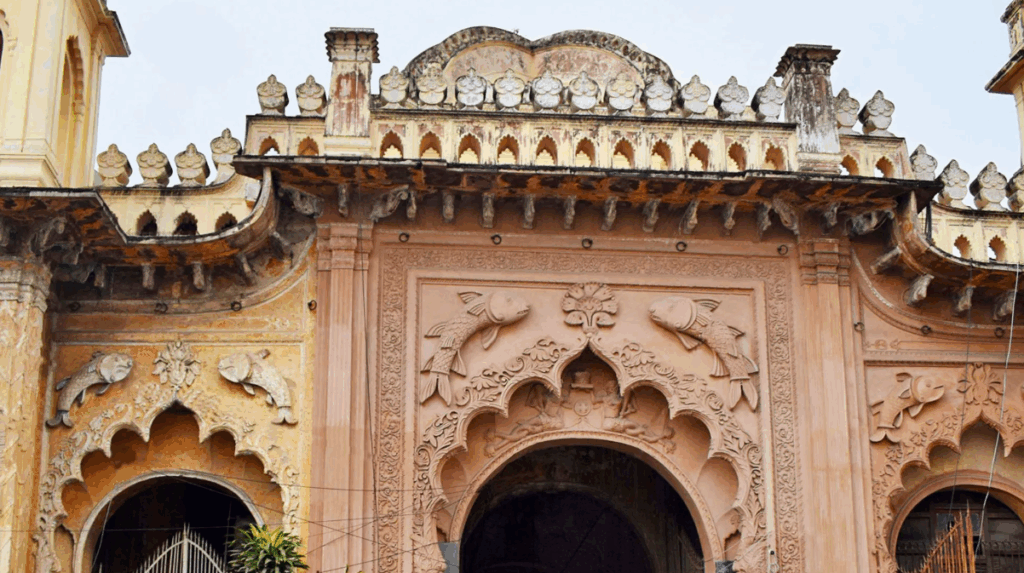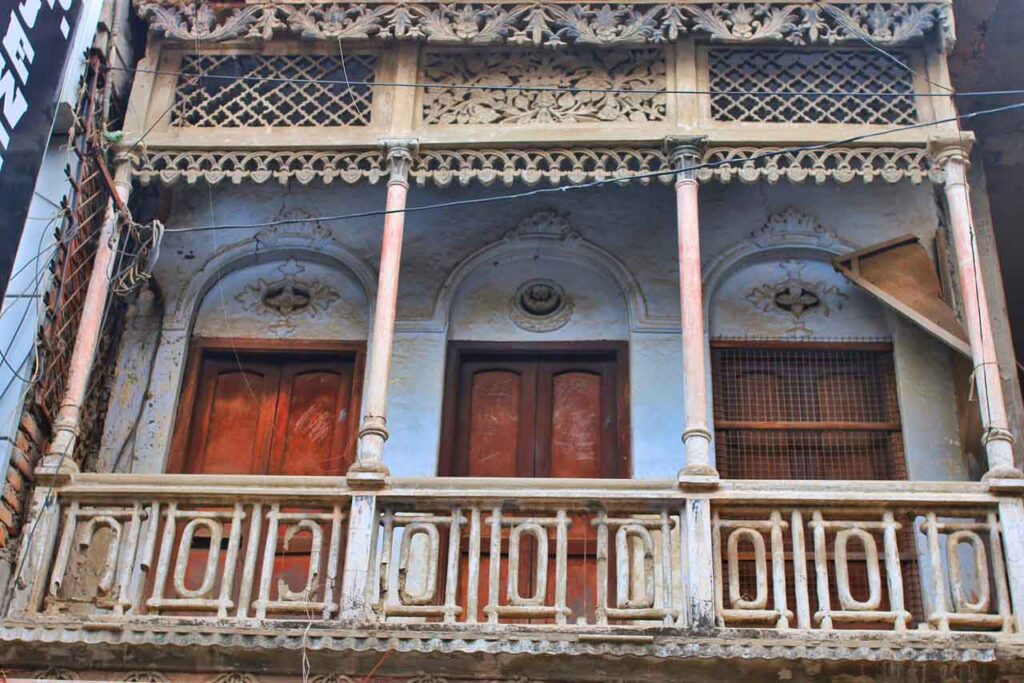Lucknow is famous for polite speech, kebabs, and graceful dance, yet its greatest gift may be the quiet homes that still line the narrow lanes of Chowk, Kaiserbagh, and Aminabad. Built two hundred years ago with local clay, slaked lime (चूना), and hand-carved timber, these havelis and imambaras show how builders once worked with the climate, not against it.
In scorching May afternoons, their inner rooms stay cool; during the July rains, their thin brick domes shed water like lotus leaves. Every carved flower (गुल-दस्ता) on a lime wall is not only decoration but part of the structure that keeps the roof steady.

Let’s take you through the simple, clever tricks that made such comfort possible—tiny lakhauri bricks (लखौरी ईंट), lime-and-brick-dust mortar (चूना-सूरखी), hidden courtyards (आँगन), and deep overhangs (छज्जा).
You will see why old masons mixed jaggery (गुड़) and bael gum into plaster, how underground rooms (तैखाना) stayed eight degrees cooler, and why today’s conservation teams still copy those recipes. By the end, you may look at a peeling lime façade and realise it is not merely old—it is a handbook for strong, climate-wise building in any hot city.
A Short Journey Through Time
Lucknow stands on the flat banks of the Gomti River. When the Nawabs of Awadh began to rule in the late 1700s, they wanted homes, palaces, imambaras, and bazaars that looked grand but stayed cool in hot summers. Stone was hard to find, so builders used local clay to make very thin burnt-clay bricks called lakhauri bricks (लखौरी ईंट).
They glued these bricks with a strong lime-and-brick-dust paste known as chuna-surkhi mortar (चूना-सूरखी). This clever choice let workers raise high arches (mehraab महराब), wide vaults (gonbad गुम्बद), and huge courts without heavy buttresses.
The style that grew from these tricks is now called the Lucknow school of architecture. Many famous sites—Bara Imambara, Chota Imambara, Rumi Darwaza, old havelis—still use the same bones.
Building Blocks and What They Do
| Thing | Local Name | Why It Is Special | Where It Goes |
| Thin burnt-clay brick | lakhauri eet (लखौरी ईंट) | Light, easy to curve, needs little fuel to fire | Domes, vaults, arch rings |
| Lime + brick-dust paste | chuna-surkhi (चूना-सूरखी) | Breathes, lasts long, works like soft glue | All masonry joints, foundations |
| Polished lime plaster | chunam (चूनाम) | Shines like marble, bounces heat, seals cracks | Outside skin, carved flowers |
| Timber of sal or teak | saal / sagwan (साल / सागवान) | Fights termites, bends under load without snapping | Roof beams, balcony brackets |
| Broken brick fill | kooda eet (कूड़ा ईंट) | Cheap, traps air, keeps rooms cool | Roof layers, fill above vault crowns |
| Natural roof coat | lai-khariya (लाई-खरियां) lime + sand slurry | Stops leaks, reflects sunlight | Final coat over terrace roofs |
Note: Old masons often mixed jaggery (गुड़), bael fruit gum (बेल गोंद), and egg white (अंडा सफेदी) into the lime. These gave extra stick and a soft gleam. INTACH’s Lime Research & Testing Centre in Lucknow still trains workers to follow the same recipe today.
From Soil to Standing Wall – Every Step
Base Pad (buniad बुनियाद)
Because Lucknow sits on deep river mud, heavy stone would sink. Builders dug only one to one-and-a-half feet, spread layers of broken lakhauri, sand, and lime, then stomped each layer tight. This thin but wide pad shared weight like a snowshoe.
First Courses
The first three rows of bricks were laid in a khunya bond (खुनिया बंध). Joints in one row never stood right over joints in the next. This zig-zag pattern stopped cracks from marching straight up.
Climbing Walls
Walls went up about 9–11 inches thick—surprisingly slim—because the lime mortar stayed flexible. After every four feet of height, workers packed a perch band (patia पटिया) made of thick chunam. It tied the layers like a belt.
Arches and Vaults
Carpenters cut light wooden ribs, fixed them in place, and tied cane strips (बेंत) across. Masons set bricks on edge over this form, tapping each one into wet mortar. Once the paste set, the ribs came out, and the arch kept its shape.

Roof Terrace (chat छत)
Roofs carried four layers:
- Broken brick and lime for slope
- Coarse lime concrete
- Fine lime plaster
- Smooth lai-khariya slurry, burnished with a stone
This sandwich blocked the pounding sun and sent monsoon rain off the edges.
Keeping Cool Without Fans
Lucknow peaks at 45 °C in May. Yet old homes feel pleasant inside. How?
- Courtyard (angan आँगन). A rectangle open to the sky. Hot air rises here like smoke in a chimney, drawing cooler air through shady rooms around it.
- Underground room (taikhana तैखाना). A full floor dug below earth, lined with lime. Earth acts as a giant clay pot, giving a natural chill even at noon.
- Deep overhang (chhajja छज्जा). Lime slabs stick out two to three feet. They stop fierce sun from hitting walls directly.
- Lattice screen (jali जाली). Cut-out patterns scatter sunlight, allow breeze, and guard women’s privacy.
- Roof night bedding. Families hauled cotton beds (char-pai चर-पाई) to the roof after sunset. The thick lime slab slowly released coolness all night.
These tricks use no power, only smart flow of air and choice of material.
Art in the Service of Strength
Lucknow artists never wasted a surface. When the lime plaster was still fresh, they carved flowers (gul-dasta गुल-दस्ता) and Qur’an verses. This carving was both beauty and maintenance: it closed micro-gaps where water could slip.
- Stucco flowers (nakashi नकाशी). Small knives trimmed leaf shapes that stood proud only a few millimetres but looked deep thanks to shadows.
- Fish emblem (machhli मछली). Two fish facing each other—the royal seal of Awadh—often sat above gateways.
- Moon stars on ceilings. Circles and stars carried by ribs of lime stucco also stiffened the dome from inside.

Everything pretty had a job to do—hold, seal, or stiffen.
Borrowing and Blending Outside Ideas
From 1780 onward, French officers and British residents lived in Lucknow. They loved Greek columns, Gothic pinnacles, and cast-iron railings—new to the city.
Local craftsmen copied these shapes in chunam, moulding shafts, bases, and leafy Corinthian capitals by hand, yet they kept the same lakhauri core. So a visitor today may see a palace front that looks European, but behind the lime skin lies a pure Awadhi skeleton of thin brick and soft mortar.
Case Note: Bara Imambara
- Built: 1784–91 by Nawab Asaf-ud-Daula
- Aim: Give work during a deadly famine
- Span: Main vaulted hall measures 50 × 16 m with no internal columns
- How it stands:
- 13-inch-thick lakhauri vault as light as a basket
- Outside buttresses hidden in the surrounding galleries
- Terraced roof with clay bowls to cut weight
- Lime plaster polished like marble
- 13-inch-thick lakhauri vault as light as a basket
Even today, guides clap inside the hall and point to the echo that jumps across the thin brick vault.
How Repairs Are Done Today?
Cement arrived in India in the 1900s. Many owners patched walls with cement because it sets fast. Yet cement is hard and non-porous; trapped salts chew the soft lakhauri brick, causing flaking. Conservation teams now follow these steps:
- Mapping cracks with chalk lines.
- Hydrating dry lime plaster with a fine mist so it swells back.
- Removing cement by a gentle hand chisel where it touches old lime.
- Injecting flowing lime grout (दूध-कच्चा चूना) into empty joints.
- Stitching bricks with stainless pins if a big gap threatens collapse.
- Re-plastering with the same ratio of lime, surkhi, and natural additives.
- Final burnish with black river stone (काल-पत्थर) and coconut oil for water resistance.
INTACH workshops teach mason teams this full cycle each winter. Workers also learn how to fire new lakhauri bricks in clamp kilns to match old size and colour. After firing, each brick is dipped in hot lime water; the slight crust bonds better with fresh mortar later.
Why These Old Tricks Still Matter
- Low energy. Making thin bricks uses less clay and fuel than big modern bricks.
- Breathable walls. Lime takes in and lets out moisture, avoiding mould.
- Local jobs. Lime and brick work need hands, not machines, so money stays with neighbourhood craft groups.
- Climate fit. Passive cooling cuts power bills in a city that touches 45 °C.
- Culture. Courtyards, jaalis, and carved flowers carry stories that shape Lucknow’s identity.

Modern architects reuse these ideas. Some boutique hotels near Chowk market now rebuild lost havelis using lakhauri, taikhana guest rooms, and chunam shining like marble.
Quick Tricks for Homeowners
- Hunt hairline cracks each spring. Rub wet lime putty into them before the June rains.
- Keep roof terrace clean. Fallen leaves trap water; sweep weekly.
- Use limewash, not cement paint. Two coats every third year let the wall breathe.
- Trim plants near walls. Roots sip water from the wall and create damp spots.
- Vent bathrooms well. Steam finds the softest path into lime plaster; a small exhaust fan helps.
Frequently Asked Questions
Why do lakhauri bricks look so thin?
They were shaped like biscuits—about 22 × 10 × 3 cm—so they could bend into curves easily. Thin bricks also weigh less, so large arches push less sideways. This saves space and material.
Is chunam costly to make today?
Material cost is low, but labour takes time. Lime must soak for at least 15 days. Yet once polished, chunam can last fifty years with minor limewash, making it cheaper in the long run.

My old wall has salt stains (सफेद दाग). What should I do?
Brush off loose powder with a dry coconut brush, spray water lightly, let it dry, then wipe with fresh limewater mixed with jaggery. Do not seal with cement paint; it traps more salt.
Can new homes use taikhanas in the city?
Rules differ, but many plots allow a basement. If planned with lime plaster and cross-vent pipes, a basement can work like a traditional taikhana without modern air-conditioning.
How strong are lime mortars in earthquakes?
Lime is softer than cement, so it flexes a little and returns. Studies show lime-brick walls resist small tremors well because they share stress across many thin joints. Steel ties hidden in plaster add extra safety for larger quakes.
Words to Take Home
Lucknow’s heritage homes grew from plain river mud, burnt into slim bricks, glued with soft lime, cooled by hidden courtyards, and decorated by steady hands. They prove that comfort, beauty, and strength can rise from simple local stuff when guided by skill.
Saving these homes does more than guard memories; it offers ready-made lessons on living kindly with the climate, creating jobs for hand-craft workers, and shaping streets that feel human. When you walk past a carved lime flower in the old city lanes, remember: that flower still holds up the roof above—quiet proof that smart craft never grows old.
